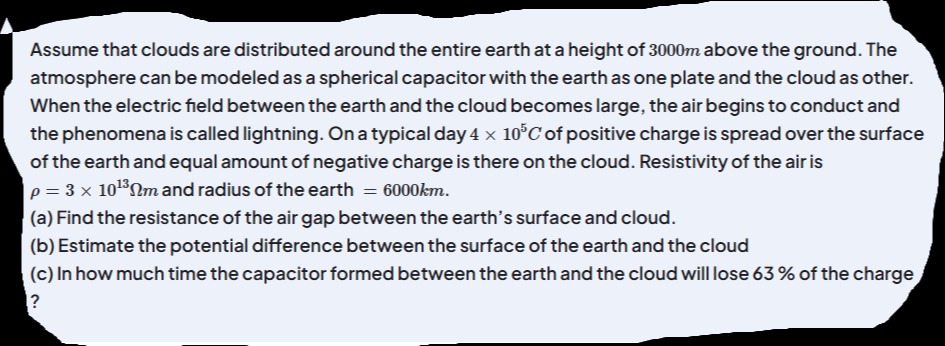Question
Question: Assume that clouds are distributed around the entire earth at a height of 3000m above the ground. Th...
Assume that clouds are distributed around the entire earth at a height of 3000m above the ground. The atmosphere can be modeled as a spherical capacitor with the earth as one plate and the cloud as other. When the electric field between the earth and the cloud becomes large, the air begins to conduct and the phenomena is called lightning. On a typical day 4×105C of positive charge is spread over the surface of the earth and equal amount of negative charge is there on the cloud. Resistivity of the air is ρ=3×1013Ωm and radius of the earth = 6000km. (a) Find the resistance of the air gap between the earth's surface and cloud. (b) Estimate the potential difference between the surface of the earth and the cloud (c) In how much time the capacitor formed between the earth and the cloud will lose 63% of the charge?

(a) 198.9 Ω (b) 3 × 10^5 V (c) 265.5 s
Solution
The problem describes the Earth-cloud system as a spherical capacitor, with the Earth as the inner plate and the cloud as the outer plate. The air between them acts as a dielectric and a resistive medium.
Given values:
- Height of cloud, h=3000 m=3×103 m
- Charge, Q=4×105 C
- Resistivity of air, ρ=3×1013Ω m
- Radius of Earth, RE=6000 km=6×106 m
- Permittivity of free space, ϵ0=8.85×10−12 F/m
Let R1=RE be the inner radius and R2=RE+h be the outer radius. R1=6×106 m R2=6×106+3×103=6.003×106 m
(a) Find the resistance of the air gap between the earth's surface and cloud.
For a spherical shell of thickness dr at radius r, the differential resistance dR is given by: dR=ρ4πr2dr To find the total resistance R, we integrate dR from R1 to R2: R=∫R1R24πr2ρdr=4πρ[−r1]R1R2 R=4πρ(R11−R21) Substitute the values: R=4π3×1013Ω m(6×106 m1−6.003×106 m1) R=4π3×1013((6×106)(6.003×106)6.003×106−6×106) R=4π3×1013(36.018×10120.003×106) R=4π3×1013(3.6018×10133×103) R=4π×3.6018×10139×1016=4π×3.60189×103 R≈12.566×3.60189000≈45.259000≈198.89Ω
Since h≪RE, we can also use the parallel plate approximation for resistance: R≈ρAh, where A=4πRE2. R≈4π(6×106 m)23×1013Ω m×3×103 m=4π×36×10129×1016=144π9×104≈452.3990000≈198.9Ω. The results are consistent.
(b) Estimate the potential difference between the surface of the earth and the cloud.
First, calculate the capacitance C of the spherical capacitor: C=4πϵ0R2−R1R1R2=4πϵ0hRE(RE+h) Substitute the values: C=4π(8.85×10−12 F/m)3×103 m(6×106 m)(6.003×106 m) C=4π(8.85×10−12)3×10336.018×1012 C=4π(8.85×10−12)(12.006×109) C=4π×8.85×12.006×10−3 F C≈1.3357 F
Now, calculate the potential difference V=Q/C: V=1.3357 F4×105 C V≈2.994×105 V≈3×105 V
(c) In how much time the capacitor formed between the earth and the cloud will lose 63% of the charge?
The discharge of a capacitor through a resistor is governed by the equation Q(t)=Q0e−t/τ, where τ=RC is the time constant. Losing 63% of the charge means the remaining charge is Q(t)=Q0−0.63Q0=0.37Q0. So, 0.37Q0=Q0e−t/τ 0.37=e−t/τ Taking natural logarithm on both sides: ln(0.37)=−t/τ −0.994=−t/τ t≈0.994τ≈τ
This means that the time taken to lose 63% of the charge is approximately equal to the time constant τ. τ=RC τ=(198.89Ω)×(1.3357 F) τ≈265.5 s
The time required is approximately 265.5 seconds.
